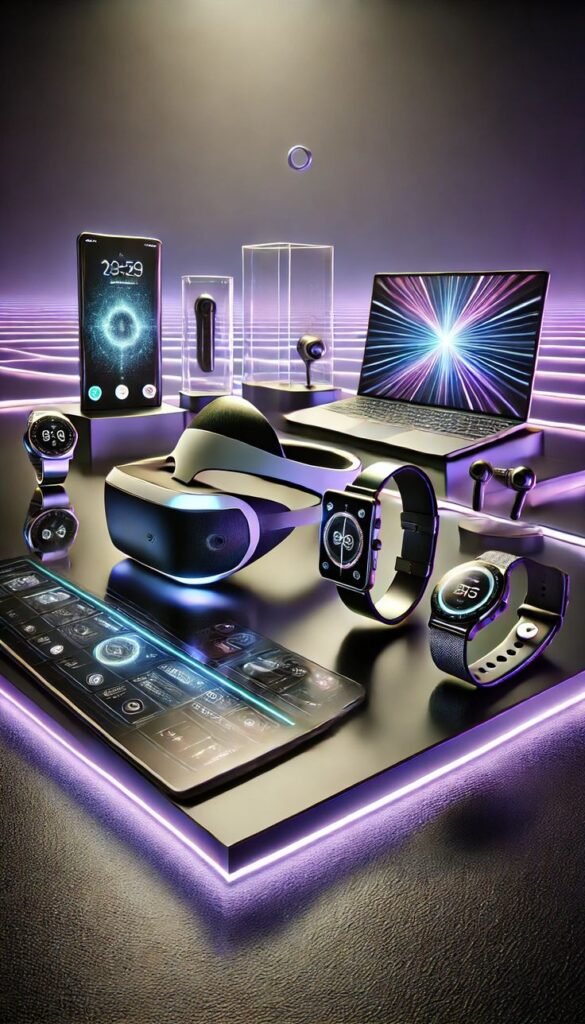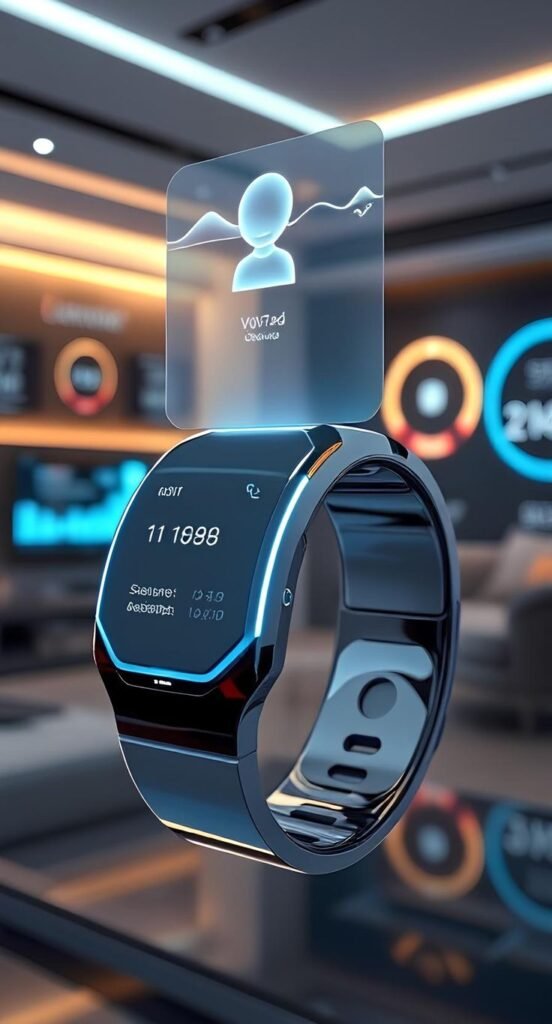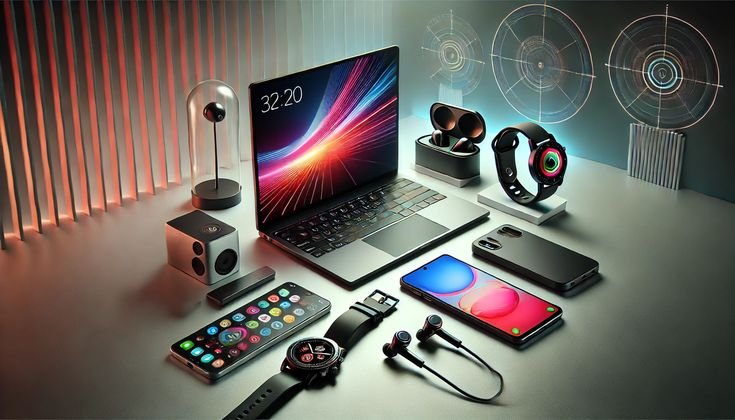Introduction: The Rapidly Evolving Tech Trends Landscape
Tech Trends has always been the heartbeat of human progress, but in the 21st century, innovation is moving at an unprecedented pace. What once seemed like science fiction—artificial intelligence, immersive virtual worlds, or quantum-powered computers—is now becoming a reality, reshaping the way we live, work, and connect. As we step into 2025, the digital revolution is no longer a distant future; it is the present unfolding before our eyes.
The year 2025 marks a turning point where multiple Tech Trends are converging. Artificial intelligence is no longer just powering chatbots—it’s transforming industries, from healthcare to finance. Quantum computing, once confined to research labs, is beginning to solve problems beyond the reach of classical computers. Meanwhile, the arrival of 5G and the early foundations of 6G are unlocking speeds and connectivity that will redefine communication.
But this transformation isn’t limited to connectivity and computing. Robotics is stepping out of factories and into our homes. Augmented and virtual reality are revolutionizing learning, gaming, and collaboration. Green Tech Trends are driving sustainability in a climate-conscious world, while biotechnology is blurring the line between human biology and Tech Trends. Even beyond Earth, advancements in space exploration are opening doors to new frontiers.
Yet, with opportunity comes responsibility. Cybersecurity threats grow in parallel with digital expansion, raising questions about privacy, trust, and resilience. Ethical frameworks around AI, bio Tech Trends, and data usage are now as important as the Tech Trends themselves.
In this article, we’ll explore 10 game-changing tech trends shaping 2025, diving into how they work, why they matter, and what their future impact could be. These innovations aren’t just Tech Trends milestones—they’re the foundation of a new era.
Trend 1: Artificial Intelligence at Scale
Artificial Intelligence (AI) has been the defining Tech Trends of the last decade, but by 2025, it has reached a new scale—permeating nearly every industry and reshaping how organizations, governments, and individuals operate. What was once considered “emerging tech” is now deeply integrated into the global economy, powering decision-making, automation, and creativity.
From Narrow AI to Generative Intelligence
Initially, AI was primarily focused on narrow tasks—image recognition, chatbots, or predictive analytics. In 2025, the rise of generative AI models, capable of producing text, images, code, and even video, has expanded the creative and operational boundaries of what machines can do. Businesses use AI to generate marketing campaigns, architects rely on it to design sustainable buildings, and scientists use it to model complex climate or medical scenarios.
Generative AI’s impact is most visible in industries like:
- Healthcare → AI algorithms detect diseases earlier than human doctors, and generative models help create tailored treatment plans.
- Education → Personalized AI tutors guide students, adapting lessons to their unique pace and learning style.
- Entertainment → AI tools co-create music, films, and video games, merging human imagination with machine precision.

AI and Business Transformation
For companies, AI has become the backbone of digital transformation. Predictive analytics optimize supply chains, customer service bots reduce operational costs, and AI-driven personalization creates better consumer experiences. In finance, AI models are capable of detecting fraudulent transactions in milliseconds, while in retail, they forecast customer demand with unmatched accuracy.
At scale, AI isn’t just a tool—it’s a competitive advantage. Organizations that effectively leverage AI are pulling ahead, leaving traditional firms struggling to keep up. This divide has given rise to the term “AI gap,” referring to the widening performance difference between AI-powered companies and those without it.
Ethics and Regulation in 2025
With rapid growth, however, come pressing ethical concerns. AI bias, data privacy, and the displacement of human jobs remain global debates. By 2025, governments and international bodies are working to establish regulatory frameworks to ensure AI use is fair, transparent, and accountable. Laws require explainable AI in critical sectors like healthcare and justice, preventing “black box” decision-making.
Moreover, the conversation around AI and employment is complex. While automation eliminates repetitive jobs, it also creates new roles—AI trainers, ethics officers, and prompt engineers. The challenge lies in reskilling the workforce to adapt to these shifts.
The Path Ahead
Looking forward, the vision of AI in 2025 is not about replacing humans but augmenting human potential. Doctors, engineers, artists, and entrepreneurs are discovering that AI can handle repetitive and data-heavy work, freeing people to focus on strategy, creativity, and innovation.
As AI scales globally, it becomes clear: this Tech Trends is not just shaping the future—it is the future. The societies and businesses that embrace it responsibly will lead in the digital age.
Trend 2: Quantum Computing Breakthroughs
Quantum computing has long been one of the most anticipated Tech Trends and by 2025, it has begun to move beyond theoretical promise into practical application. Unlike classical computers, which process information in binary (0s and 1s), quantum computers use qubits, which can exist in multiple states simultaneously. This ability to perform parallel calculations unlocks exponential processing power, making quantum computing ideal for problems too complex for even the fastest supercomputers.
From Lab to Real-World Applications
For decades, quantum computing was restricted to research labs, with prototypes requiring extreme cooling systems and fragile setups. However, recent advancements in quantum error correction, hardware stability, and cloud-based accessibility have pushed the field closer to commercial viability. By 2025, leading Tech Trends giants and startups alike are offering quantum-computing-as-a-service (QCaaS), making it possible for researchers, businesses, and even governments to tap into quantum power via the cloud.
Industries Revolutionized by Quantum Power
The potential impact of quantum computing is massive:
- Healthcare & Drug Discovery → Quantum algorithms simulate molecular interactions with incredible accuracy, drastically reducing the time needed to develop new medicines and vaccines.
- Finance → Banks and investment firms use quantum systems to optimize portfolios, detect fraud, and model market behaviors far more effectively than classical computers.
- Logistics & Supply Chains → Complex optimization problems, like global shipping routes or warehouse distribution, are solved in seconds.
- Climate Science → Quantum simulations provide deeper insights into climate models, helping predict natural disasters and design sustainable solutions.
Challenges and Risks
Despite breakthroughs, quantum computing is not without challenges. Scalability remains a major hurdle—most systems are still limited in the number of qubits. Furthermore, the rise of quantum computing poses a serious risk to current encryption methods. Traditional cybersecurity systems like RSA encryption could be cracked in minutes by powerful quantum machines. To counter this, researchers are racing to develop post-quantum cryptography that can withstand quantum-level attacks.
The Road Ahead
By 2025, quantum computing is not yet mainstream for everyday use, but it is rapidly becoming a strategic tool for industries with complex computational needs. Governments and corporations are investing heavily, recognizing that the “quantum advantage”—the moment when quantum computers outperform classical ones in solving meaningful problems—will define the next era of innovation.
Quantum computing may still be in its early stages, but its breakthroughs in 2025 mark the dawn of a new computational age—one that will reshape science, security, and society in ways we are only beginning to imagine.
Trend 3: 5G and the Dawn of 6G Networks
Connectivity is the backbone of digital innovation, and by 2025, the rollout of 5G networks has already transformed how people and devices interact. But even as 5G becomes the global standard, researchers and telecom giants are laying the groundwork for 6G, which promises even faster, more intelligent, and more immersive digital experiences.
5G in Action
The introduction of 5G has brought lightning-fast download speeds, ultra-low latency, and the capacity to connect millions of devices simultaneously. By 2025, this Tech Trends has enabled:
- Smart Cities → Real-time traffic management, energy-efficient grids, and responsive public services.
- Healthcare → Remote surgeries using robotic arms connected through ultra-reliable 5G networks.
- Autonomous Vehicles → Cars communicating with each other and with city infrastructure to prevent accidents.
- Immersive Entertainment → High-quality VR and AR experiences streamed without lag, transforming gaming, sports, and education.
5G isn’t just faster internet—it’s the foundation for the Internet of Everything, enabling billions of devices, sensors, and systems to function seamlessly.

The Rise of 6G
While 5G is still being expanded worldwide, the seeds of 6G networks are already being planted. Expected to debut around 2030, early research in 2025 shows that 6G could deliver speeds up to 100 times faster than 5G and offer near-instantaneous communication. More than just speed, 6G aims to integrate AI at the network level, making data transmission adaptive and intelligent.
Potential breakthroughs with 6G include:
- Holographic Communication → Real-time holograms for meetings, entertainment, and learning.
- Hyper-Connected IoT → Trillions of sensors and devices working together to monitor everything from personal health to planetary ecosystems.
- Brain-Computer Interfaces (BCIs) → Direct communication between human thought and digital systems, supported by ultra-fast connections.
Challenges Ahead
Despite its promise, the expansion of 5G and the development of 6G face challenges. Infrastructure costs remain high, especially in developing regions. Security concerns are also intensifying as more critical systems depend on network stability. With billions of connected devices, the risk of cyberattacks grows exponentially.
The Future of Connectivity
By 2025, 5G has already laid the foundation for a hyper-connected society, while 6G represents the next leap toward a seamlessly digital and immersive world. Together, they will shape not only communication but also the way humans experience reality itself.
Trend 4: Extended Reality (AR, VR, MR)
The boundaries between the digital and physical worlds are blurring faster than ever. By 2025, Extended Reality (XR)—the umbrella term for Augmented Reality (AR), Virtual Reality (VR), and Mixed Reality (MR)—is transforming industries, entertainment, and everyday life. What was once limited to gaming headsets has now expanded into business, healthcare, education, and beyond.
Virtual Reality: Fully Immersive Worlds
VR Tech Trends has matured significantly. With lighter headsets, improved resolution, and wireless connectivity powered by 5G, VR is no longer niche. In 2025, VR is:
- Education & Training → Medical students practice surgeries in hyper-realistic simulations.
- Corporate Workspaces → Teams collaborate in virtual offices, replacing endless video calls.
- Entertainment → Concerts, museums, and theme parks offer VR experiences accessible from home.
VR is not just about gaming anymore—it’s becoming a tool for productivity, creativity, and connection.
Augmented Reality: Digital Layers on Real Life
AR overlays digital information on the physical world. By 2025, AR is embedded in smart glasses and even car windshields. Examples include:
- Retail → Shoppers “try on” clothes, makeup, or furniture virtually before buying.
- Healthcare → Surgeons see real-time patient data during operations via AR displays.
- Navigation → Drivers and pedestrians follow AR arrows projected on streets or sidewalks.
AR has made digital information seamless and accessible in daily life.
Mixed Reality: The Best of Both Worlds
MR combines AR and VR, allowing users to interact with digital objects in the real world. For example, engineers can design a 3D prototype and manipulate it as if it were a physical object. In 2025, MR is revolutionizing product design, architecture, and remote collaboration, making creative processes more efficient.
Opportunities and Concerns
While XR opens doors to innovation, it also raises challenges. Extended use of immersive environments sparks debates about mental health, addiction, and social isolation. Privacy concerns also arise, as AR devices constantly collect data about surroundings and behavior.
The Future of XR
By 2025, Extended Reality is no longer a futuristic concept—it’s part of daily routines. From virtual classrooms to AR-driven shopping, XR has become a mainstream gateway to digital interaction. As hardware becomes more affordable and software more sophisticated, the line between real and virtual will only continue to fade.
Trend 5: Green Tech Trends & Sustainable Innovation
As the climate crisis intensifies, 2025 is a defining year for the rise of green Tech Trends and sustainable innovation. Governments, corporations, and consumers are realizing that Tech Trends must not only drive growth but also protect the planet. From renewable energy to eco-friendly materials, sustainability is no longer optional—it’s essential.
Renewable Energy at Scale
By 2025, renewable energy sources like solar, wind, and hydropower account for a growing share of the global energy mix. Breakthroughs in solar panel efficiency, offshore wind farms, and smart grids are making clean energy more reliable and affordable. Energy storage innovations, such as solid-state batteries, allow renewable power to be stored and distributed more effectively, reducing dependence on fossil fuels.
Smart Cities and Sustainable Living
Urbanization is accelerating, but so are efforts to make cities greener. Smart city Tech Trends powered by IoT sensors optimize energy consumption, reduce traffic congestion, and improve waste management. Buildings are designed with green architecture principles, using recycled materials, self-sustaining energy systems, and AI-driven climate control to minimize carbon footprints.
Sustainable Consumer Tech Trends
Tech Trends companies are under pressure to adopt circular economy models—designing products that can be reused, repaired, or recycled. By 2025:
- Smartphones and laptops increasingly use recycled metals and biodegradable materials.
- Companies offer “right-to-repair” policies, reducing electronic waste.
- Wearable devices track not only health but also personal carbon footprints, encouraging eco-conscious behavior.
Agritech and Food Sustainability
Green innovation extends to agriculture, where vertical farming, precision agriculture, and lab-grown meat are addressing global food challenges. AI-driven drones monitor crops, reducing water and pesticide usage, while hydroponics and aeroponics allow food production in urban spaces with minimal land use.
Challenges and Global Collaboration
Despite progress, challenges remain. Green Tech Trends often requires high upfront investment, making adoption slower in developing countries. Moreover, global policies must align to regulate emissions and support renewable initiatives. Encouragingly, multinational collaborations and climate-focused Tech Trends startups are bridging the gap, proving that innovation can be profitable and sustainable.
The Green Future
By 2025, green Tech Trends is not just about reducing harm—it’s about creating opportunity. Sustainable innovation is driving new markets, jobs, and lifestyles, showing that economic growth and environmental responsibility can go hand in hand. In the long run, the Tech Trends that save the planet will also define the future of human civilization.

Trend 6: Cybersecurity & Zero Trust Models
As the digital world expands, so do the risks. By 2025, cyber threats have grown more sophisticated, frequent, and costly, making cybersecurity one of the most critical areas of Tech Trends focus. With billions of devices connected via 5G and early 6G networks, the attack surface has multiplied, forcing organizations and governments to rethink security strategies.
The Growing Cyber Threat Landscape
Cybercriminals are leveraging AI and automation to launch advanced attacks. Ransomware, once aimed at individuals and small businesses, now targets entire cities, hospitals, and multinational corporations. Phishing campaigns have become nearly indistinguishable from genuine communication, while deepfakes and synthetic media introduce new forms of deception.
Critical infrastructure—such as power grids, water systems, and transportation—faces increasing threats, raising concerns about cyber warfare and national security. In 2025, cybersecurity is no longer an IT issue; it is a global priority.
The Zero Trust Security Model
To combat these evolving threats, organizations are widely adopting the Zero Trust model. Unlike traditional security approaches that assume internal networks are safe, Zero Trust operates under the principle of “never trust, always verify.”
Key aspects of Zero Trust in 2025 include:
- Identity Verification → Multi-factor authentication and biometric access as default.
- Micro-Segmentation → Dividing networks into secure zones, limiting lateral movement by attackers.
- Continuous Monitoring → Real-time threat detection powered by AI and machine learning.
Zero Trust minimizes the damage of breaches by assuming every connection could be compromised.
AI and Automation in Cyber Defense
Just as hackers use AI to exploit systems, defenders are using it to predict, detect, and neutralize attacks faster than ever. Automated security systems can analyze billions of data points in seconds, spotting unusual behavior before it escalates. In 2025, cybersecurity is increasingly about AI vs. AI battles.
Challenges and Human Factor
Even with advanced systems, humans remain the weakest link. Social engineering attacks exploit trust and emotions, bypassing Tech Trends defenses. This has made cybersecurity training a standard part of both corporate and school education, ensuring people can recognize and respond to threats.
The Future of Cybersecurity
By 2025, cybersecurity is a constant race between innovation and exploitation. The adoption of Zero Trust, AI-driven defenses, and global regulations is strengthening resilience, but the stakes remain high. In a hyper-connected world, cybersecurity is no longer optional—it is the foundation of digital trust.
Related Post: 10 Key Facts About Julie Tsirkin: A Comprehensive Biography

